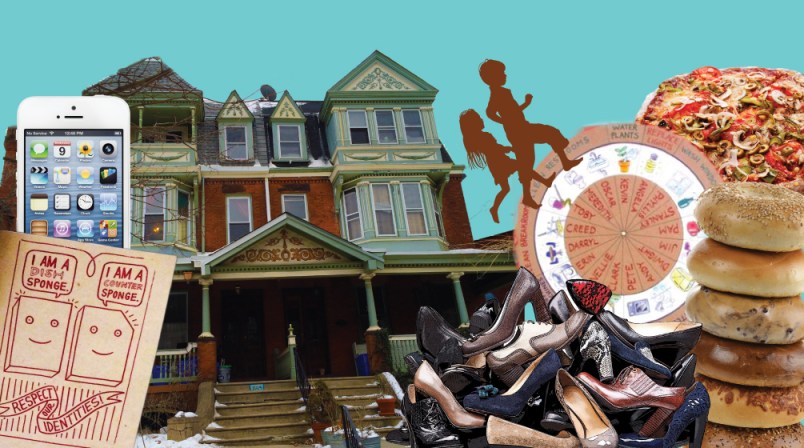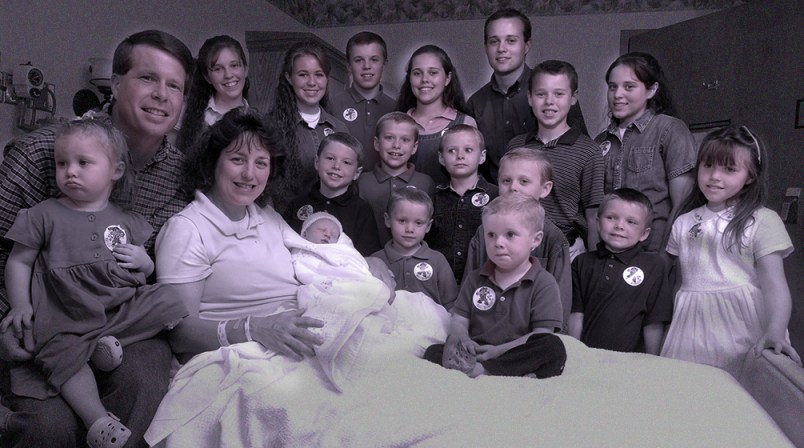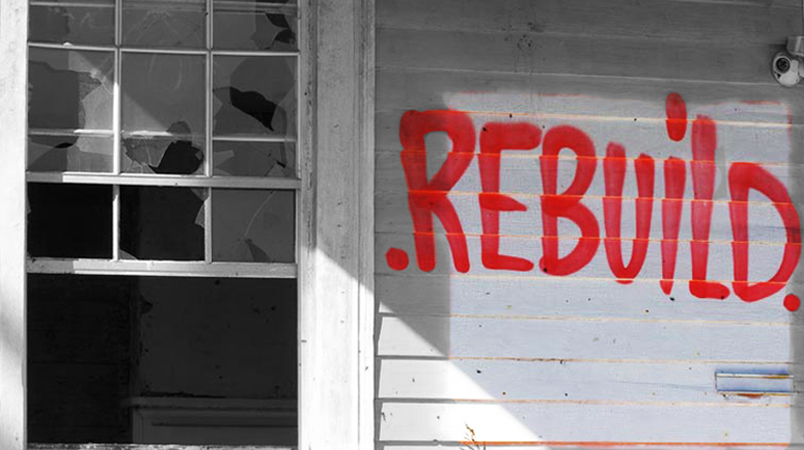One might think the house would look different from the others. It doesn’t, really—there are rows of peaked, double-wide Victorians just like it on this side street in West Philly. But once you step inside it’s a different story. The same way that minimalist furniture signals wealth or mustard-colored shag carpeting recalls the 1970s, the sheer density of stuff in this expansive foyer is unmistakably that of a collective home.
Mainly, it’s the shoes. There are three pieces of furniture intended to contain all these shoes, and then there are bins holding the run-off—forty pairs is probably a conservative estimate. And at the center of this shoe-storing area, there is a repurposed vanity containing all the other “Honey, I’m Home” objects, a dense tangle of keys and sunglasses and pieces of mail, bike locks and a roll of electrical tape.
I’m here, at the home of seven adults not related by blood and two children, to find out why one would choose to live somewhere that requires such an extreme shoe-storage situation. What does it look like, in an age of post-recession scarcity, for a group of people to successfully weather their late twenties and early thirties together, to embark on the great child-rearing mission in a shared home?
It’s a task many consider utopic at best, delusional at worst; say “communal living” or “intentional community” to most Americans and you’ll conjure visions of dusty Northern California communes or fringe cults or punk houses with sticky floors and elaborate chore wheels. If you’re lucky, they’ll also know a little about the tech-incubator mansions in the Bay or, god forbid, the grotesque investor-backed Brooklyn communal clubhouse. And if you’re even luckier, you won’t have to explain that those last two are riffs on a longstanding tradition of collective property ownership, which includes, yes, income-sharing communes, but also non-profit housing cooperatives and their suburban-ish cousins, cohousing communities. The basic idea: to share the comforts and burdens of not only property ownership, but the political and economic realities of a household. Or, if you wanted to be cheeky about it: No gods, no masters; no bosses, no landlords.
It’s an enticing idea: After all, we’ve rightfully lost faith in all of the above. We’re living through a massive fracturing of what was once considered the American Dream—along with the equation of successful adulthood with marriage, a few kids and a two-car garage tucked away in a leafy suburban idyll.
My generation, people between the ages of 18 and 31, is the first to do worse financially than the two generations before it; crushing student debts and rampant unemployment during the recession conspired to make us, by and large, financially unstable enough that earning enough to rent a place—never mind start a mortgage—is often laughable. Five-year plans are inconceivable. We’re navigating piecemeal, contingent realities, and the traditional system of getting houses, credit cards and car loans hasn’t quite caught up with the new economy. We aren’t owning cars or homes at the same rates as our parents; as of last year, only about a quarter of us were married.
And for some of us, the choice to rear children has become something akin to a luxury good. In the last few years, the panic over whether women—or anyone, really—can afford to succeed while raising a family has reached a fever pitch. The question gnaws at people like Sheryl Sandberg and Anne-Marie Slaughter, for whom even extreme privilege is not enough to guarantee they “have it all.” In the absence of a national childcare system or longer parental leave, companies like Apple and Facebook pay for female employees to freeze their eggs. So given that the most affluent feel under the gun, how are the rest of us even supposed to consider raising children, given the financial and institutional barriers?
Knowing all this doesn’t mean people my age have come up with solutions. Even if I were the type to want 2.5 kids and a white picket fence when I “grow up,” what are my options? Save up for a down payment I won’t be able to afford until I’m 40? Shell out thousands of freelancer dollars for childcare?
If the tech industry and its boosters are to be believed, these tensions will be resolved when my smartphone-handling peers and I manifest a brave new economy wherein individual ownership is rendered obsolete. To be sure, the fact that the term “sharing economy” has been used to describe both the ruthless, market-devouring Uber and small food cooperatives popping up in Denver is a testament to the fallibility of buzzwords. Still, there’s no denying that “collaborative consumption” has come to frame a number of conversations about The Youth. Thanks to sophisticated algorithms and seamless UIs, we share rides and vacation homes, dinner and crash pads. Or, as one particularly euphoric story in Wired put it, by “entrusting complete strangers with our most valuable possessions, our personal experiences—and our very lives,” we’re “entering a new era of Internet-enabled intimacy.”
Back to the shoes: I’m here in Philly to see if that intimacy could be translated into something more meaningful than a blanket trust in the swarm, how the sharing economy could operate not as a collection of disembodied apps but as a lived experience. And to tell the truth, I’m also here because I want to know how nine humans have fared after eschewing the middle-class dream for something far more ambitious—and far riskier.

When I first started asking around about group houses with kids, I was referred to Esteban Kelly, who ends up being my host at this West Philly group house. Kelly is, at 34, one of the coolest grownups I’ve ever met. A tiny Jamaican-American originally from New York City, he has a maniacal laugh and a polished hipness, complete with vintage glasses, that make him appear about seven years younger. (By the end of my stay, Esteban will be going full Cool Dad on me, urging me to deal with my 1099 tax situation and recommending the accountant he himself uses, as a contract worker—“Oh my god,” he raves of said accountant, “he is a total freak!”)
When I arrive at the house, which calls itself “InSoFar,” I’m met at the front door by Esteban’s partner, a lean, angular Spanish teacher named Stephen Holt, and their three-year-old daughter, Anaïs. The dutiful, clearly exhausted father gives me a tour of the house and we happen upon a game of cards on the expansive second floor. I sit down next to a half-finished glass of wine on a red shag rug and watch the game; it isn’t until the doorbell rings and Anaïs toddles upstairs to announce the arrival of our pizza that I’m asked, sort of languidly, who I am and who I’m with. When I tell them, there’s a murmur of recognition. Oh, right. They got that email.

Jacques-Jean Tiziou
InSoFar is one of a handful of what I’ll hear referred to as “named houses” in West Philly—a neighborhood that’s dense enough to qualify as urban, spacious enough to provide breathing room. The organization from which the residents of InSoFar lease their home, the Life Center Association (LCA), like many longstanding cooperative institutions, has roots in the anti-Vietnam War movement.
Over thirty years or so, there were “a few waves of people going and setting up collective houses” in this part of Philadelphia, says Andrew Cornell, a professor and author of Oppose and Propose, a history of the Movement for a New Society, the group out of which LCA was formed. The LCA itself purchased a number of houses in the 1970s, and by the end of the decade it was an umbrella organization under which a publishing collective and a food cooperative also operated. This existing culture was augmented during the 1980s, when squatters built communities in decaying or derelict houses, and again in the early 2000s when rents were cheap and a younger generation started buying and fixing up properties.
It’s nearly impossible to come up with a concrete number of how many people are living collectively in the United States. In part, it’s an issue of record-keeping—but it’s also a testament to the sheer variety of collective living situations, even those centered around similar legal agreements. In New York City, co-op boards are common, but the level of communal involvement usually begins and ends with deciding who can buy a unit in the high-rise. The LCA network of houses are run as a land trust, renting out entire houses to groups who apply; many cooperatives function as nonprofit corporations, in which each “renter” buys into the institution at large.
And then there are the most famous, if often-lampooned, examples of collective living—the rural communes my parent’s generation fled America’s cities to found. Some of them, like Twin Oaks in Virginia or Black Bear Ranch in California, are still kicking, though scholars of such things agree the vast majority of back-to-the-land projects failed within their first decade. The hippie commune looms largest in the pop cultural imagination, which perhaps explains why there are still all sorts of bizarre stigmas attached to collective housing. Recently, one of InSoFar’s residents was approached by a colleague who asked her if, um, she was “partnered” with everyone she lived with or just that one guy she brings around to work happy hours sometimes.
Over pizza that night, someone brings up the “Hartford Decision.” Recently, a family of eight adults and three children living in a crumbling mansion in the economically-depressed Connecticut city were issued a cease-and-desist order after it was determined their arrangement didn’t comply the neighborhood’s single-family regulations—or, really, with the neighbors themselves, who despite telling a local paper that the residents “are nice people” formed a coalition to get them out of the nine-bedroom home.
“But if they were domestic servants, it would be legal,” yells Greg Holt, Stephen’s fraternal twin: same angular face but with a top knot. The twins spent part of their childhood in a combined two-family home in New Hampshire; they, like the other adults who live here, have significant experience living in collective homes. Some of the relationships here go back more than a decade.
Theresa Giardini, 33, grew up in Philadelphia and used to go to house shows in LCA homes when she was a teenager. In a knit cap and denim jacket, Theresa has a sharp and brassy manner that reminds me of the less self-conscious punk girls I used to hang out with in high school. Her kid, Gus, a seven-year-old with long blonde hair, is going through a Harry Potter phase, and he absentmindedly bangs on wineglasses with a chopstick and mutters incantations during dinner.
When the original group applied for and was selected to live in InSoFar, “We were all making, like, $12,000 a year,” says Theresa. “But we figured it out.”
The group moved in in 2008, just as the worst financial recession in 75 years was beginning to settle across America. Originally, the group comprised of two couples—Stephen and Esteban, sans Anaïs; Jayson, Theresa and Gus, then an infant. They were joined by Greg and a college friend of Esteban and Stephen’s, Milena Velis. Though many in the household now have stable occupations, back then, in their twenties, they “weren’t grown-ups doing professional jobs,” says Theresa—she was a TA, Esteban a grad student working part-time at Mariposa, the LCA-affiliated food cooperative, Milena a courtroom interpreter.
All of them had lived in collective houses before, and they figured their previous experiences and tightknit relationships would allow them to avoid the drama and frustration that can break other houses up. Greg ascribes part of InSoFar’s success to its pragmatism. “We didn’t think, oh, collective living is gonna be this amazing, perfect, post-capitalist beautiful community,” he says.
InSoFar is one of eight houses currently operated under the LCA banner; each home sends a representative to sit on the organization’s governing board, which manages major institution-wide decisions: for example, the criteria for maintenance expenses, for which each house is given an annual budget. Board meeting notes reflect a granular understanding of what can and can not come out of this yearly sum: maintenance must provide a long-term improvement to the building, is more functional than aesthetic, and doesn’t fall under the purview of the responsibilities of a homeowner, like mowing the lawn. Decisions are reached using 1970s-style consensus, a famously time-intensive (if aggressively democratic) process.
If that sounds a little trying, it’s because it can be. Living in an intentional community involves the kind of organizational fluency that’s difficult for anyone who hasn’t already been steeped in it.

Jacques-Jean Tiziou
The day-to-day realities of InSoFar, however, are more fluid. The pizza ordered that first night was paid for with a house food budget that’s folded in with monthly utilities, rent and a slush fund for other supplies such as tools and toiletries. There’s a shared house bank account into which each member pays what they owe. Unlike in many cooperative houses, there’s no set rotation for dinner duty or institutionalized house meetings here. Theresa cooks a lot, since she’s home earlier; the house gets together to discuss big issues as they encounter them—and they’re “not about, like, cleaning the bathroom,” says Esteban.
“We just deal with it the way you would deal with it if you live with family,” adds Theresa. And while the parents are quick to note that they’ve leaned on each other in times of crisis, they’re careful not to burden their housemates too much. Now that the kids are a little older the parents may leave them at home while they run an errand or two, but they still hire babysitters when they’re out for an evening. Much of the benefit here, I imagine, comes from having other adults around who like socializing with your children when everyone’s home, a relief that’s more psychic than logistical.
The effects of collective housing on childrearing are much more nuanced than free domestic labor. As Stephen tells me, “I learned a lot about parenting … because we lived with Gus for four years before Anaïs was born. It’s not like you know someone who has children. You’re really in the parenting.”
In InSoFar’s bright, L-shaped kitchen on a Friday night, after the kids are put to bed and more glasses of wine have been poured, the board meetings and budgeting grinds all seem worth it—the house is warm and cavernous, and Theresa is telling me that for a long time, Gus thought the word “sibling” meant people you lived with who didn’t have the same parents. Surely, this model is more enticing than what I imagine to be its polar: a perpetually exhausted set of parents finally getting Junior to bed, having given her their exclusive focus all evening, and sitting slaw-jawed in front of another episode of How I Met Your Mother before they tuck in for the night.

But of course, just as that white picket fence isn’t for everyone, neither is this. Living in a group house can require an incredible amount of tolerance for both personal and institutional conflicts; I heard whispers of LCA disasters past (using grant money to book international punk bands!) during my stay in InSoFar, and when organizational issues collide with the impassioned, deeply personal nature of domestic life, it can get messy. Theresa tells me she’s seen close relationships destroyed after failed experiments in communal living. Later, she’ll compare the intensity of arrangements like these to a modern conception of marriage: They aren’t permanent, but they are serious, and they require work.
And as it turns out, old aspirations die hard, and no matter how difficult the road to a more traditional nuclear lifestyle may be, there will always be those who, when they’re honest with themselves, still desire it. Never forget: Those dusty commune kids running around half-naked in Born to be Wild eventually turned into what we now refer to as boomers.
I get a glimpse of the enduring pull of “normal” adulthood when invited to attend a Dim Sum Chinese New Year celebration with the members of InSoFar, plus three: two of the house’s former members, Bryan Mercer, 29; Milena Velis 31; and their infant, who spends most of the meal strapped to her father’s chest. Bryan and Milena now live in an apartment a few blocks away from their former home; they tell me about their desire to one day take out a mortgage on their own house. I get the sense that everyone is still close, but that InSoFar’s vision wasn’t one that Bryan shared. When he moved into the house it was “basically to be with this one,” gesturing to his wife. It was his first and only foray into collective living; the couple stuck around two years, but when Anaïs was old enough to need her own room, they started talking about finding their own place.
“I think they wanted more privacy,” Esteban put it diplomatically, “to have a moment alone, have dinner parties.” Working long hours, the couple often wouldn’t come home until 8 pm or later; for all the social support one gets from communal living, it demands its members spend quality time at home. Which isn’t even to mention things like intimate dinners, just one of the thousands of trappings of the bourgeois good life that must be mutated or wholly abandoned to live in a collective house.
“The United States has such an emphasis on the individual, and on the family,” says Theresa. “I talk to people and they’re like, oh I couldn’t do that, I couldn’t have other people in my space.”
The story of Bryan and Milena is far from the most painful collective-housing breakup I’ve born witness to. I’ve lived in houses with loads of other people since I was eighteen, in a nonprofit housing cooperative with two-dozen childless humans aged 17 to 30, and then later in a house in Greenpoint with anywhere from seven to 12 roommates. I’ve lived in the house that’s been razed by drugs and financial mismanagement; watched relationships fester and eventually combust over something as simple as furniture placement; sat through hours-long meetings about rent repayment and wrung my hands endlessly over the order of operations when it’s time to kick someone out.
And still, I find myself arguing with skeptics, taking the side of group ownership and collective decision-making over more vanilla dreams. But for a lot of people, living with more than 3.5 people is still looked at as either a tragic financial necessity or an activity particular to one’s twenties. From your apartment to your beer, you’re supposed to acquire more expensive tastes when you grow up.
It can be tempting to deride boosters of modern collective housing by wielding the same white, educated, middle-to-upper class clichés once applied to hippies. But having spent time at InSoFar, at least, it’s clear this isn’t that kind of project. The members of InSoFar are racially, and from what I can tell, socioeconomically diverse. The most common denominator seems to be that the people who live here are committed activists, a shared set of political plot points apparent even in the way they talk about the imperative of diversity. Collective housing may seem like a good answer to our disillusionment with a broken system, but for now, it’s also a political act, not just because it provides autonomy from The Man, but because it’s an alternate model of low-income, low-impact housing in an age of rampant gentrification. It’s hard to imagine Middle America freely politicizing their living spaces.
And supposedly progressive urban Millennials probably won’t, either. If we’re really the sharing generation, it’s a particular kind of sharing we’ve been indoctrinated in, an anonymous trust that may be useful to crowdsource tasks and facilitate market relationships, but doesn’t do much to dismantle our deeply entrenched concept of ownership, or about what a family is supposed to look like. It’s far harder to develop the skills and relationships required to share a life than a room or a cab.
In other words, there is no easy fix to our generational woes. Freezing eggs, deferring that move to the suburbs, fist-bumping a Lyft driver—they don’t fundamentally alter the way we think about ourselves or our responsibility to our communities.

A few years ago, curious about the legacy of those fabled 1960s communes, I got in touch with Peter Coyote, an OG activist with ties to several rural communities and a former member of The San Francisco Mime Troupe. “We lost every political battle of the sixties,” he wrote. “We did not stop war, capitalism, racism. But on reflection, it occurred to me that we won every cultural battle.”
Coyote listed those victories: organic food in grocery stores, yoga studios, alternative medicine—all the trappings of a subculture consumed. He seemed optimistic, but as far as I was concerned, the equation of victory with new experiences for sale was pretty dark.
At the same time, our notions of the nuclear family stayed intact. The 1960s movements were born out of excess, a generation with too much time and certainty; our era, by contrast, is defined by scarcity, how unlikely it is that we’ll come close to achieving those handed-down dreams in the first place. Better, probably, to start reaching elsewhere—if we don’t, we too might win only similar cultural victories, and find instead of a more sustainable adult life only a shallow, push-button version of the sharing economy, a version dictated by some of the only people left in America who don’t even have these problems.
Molly Osberg is a writer based in New York. She’s on Twitter @molly__o.






